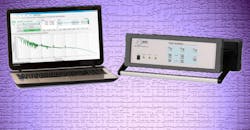Phase-Noise Tester Analyzes Noise Affordably
Growing awareness of the importance of phase noise in communications and radar systems has created a similarly growing interest in the means of measuring phase noise. Berkeley Nucleonics Corp. made some noise of its own at EDI CON 2017 with its affordable phase-noise measurement solutions (see photo), with versions available for absolute and residual phase-noise measurements at carriers from 5 MHz to 7, 26, or 40 GHz. Featuring noise floors to −188 dBc/Hz (offset 10 MHz from the carrier), the 7000 Series signal source analyzer and dedicated phase noise test systems can measure phase noise at offset frequencies from 0.01 Hz to 100 MHz.
The test systems can perform amplitude-modulated (AM) and pulsed phase-noise measurements on many types of oscillators and frequency synthesizers, using its own internal reference oscillator or an external frequency reference. In addition to its phase-noise measurement capabilities, the tester can perform spectrum analysis, frequency counting, and even transient measurements, such as frequency, phase, and amplitude versus time.
The 7000 series phase-noise testers include two programmable low-noise DC supplies for powering an oscillator or synthesizer under test and three low-noise tuning voltages for tuning voltages from −5 to +22 V dc. It provides a number of control interfaces for automatic-test-equipment (ATE) applications, and can handle input power levels of −15 to +17 dBm from 5 MHz to 2 GHz, −12 to +20 dBm from 2 to 9 GHz, −10 to +20 dBm from 9 to 18 GHz, −13 to +20 dBm from 18 to 30 GHz, and 0 to +23 dBm from 30 to 40 GHz.
The measurement accuracy is better than ±4 dB for offset frequencies of less than or equal to 1 kHz and ±2 dB for offset frequencies greater than 1 kHz. Most visitors to Berkeley Nucleonics’ EDI CON exhibition booth were pleasantly pleased by the relatively low price for such a system.
About the Author
Jack Browne
Technical Contributor
Jack Browne, Technical Contributor, has worked in technical publishing for over 30 years. He managed the content and production of three technical journals while at the American Institute of Physics, including Medical Physics and the Journal of Vacuum Science & Technology. He has been a Publisher and Editor for Penton Media, started the firm’s Wireless Symposium & Exhibition trade show in 1993, and currently serves as Technical Contributor for that company's Microwaves & RF magazine. Browne, who holds a BS in Mathematics from City College of New York and BA degrees in English and Philosophy from Fordham University, is a member of the IEEE.


